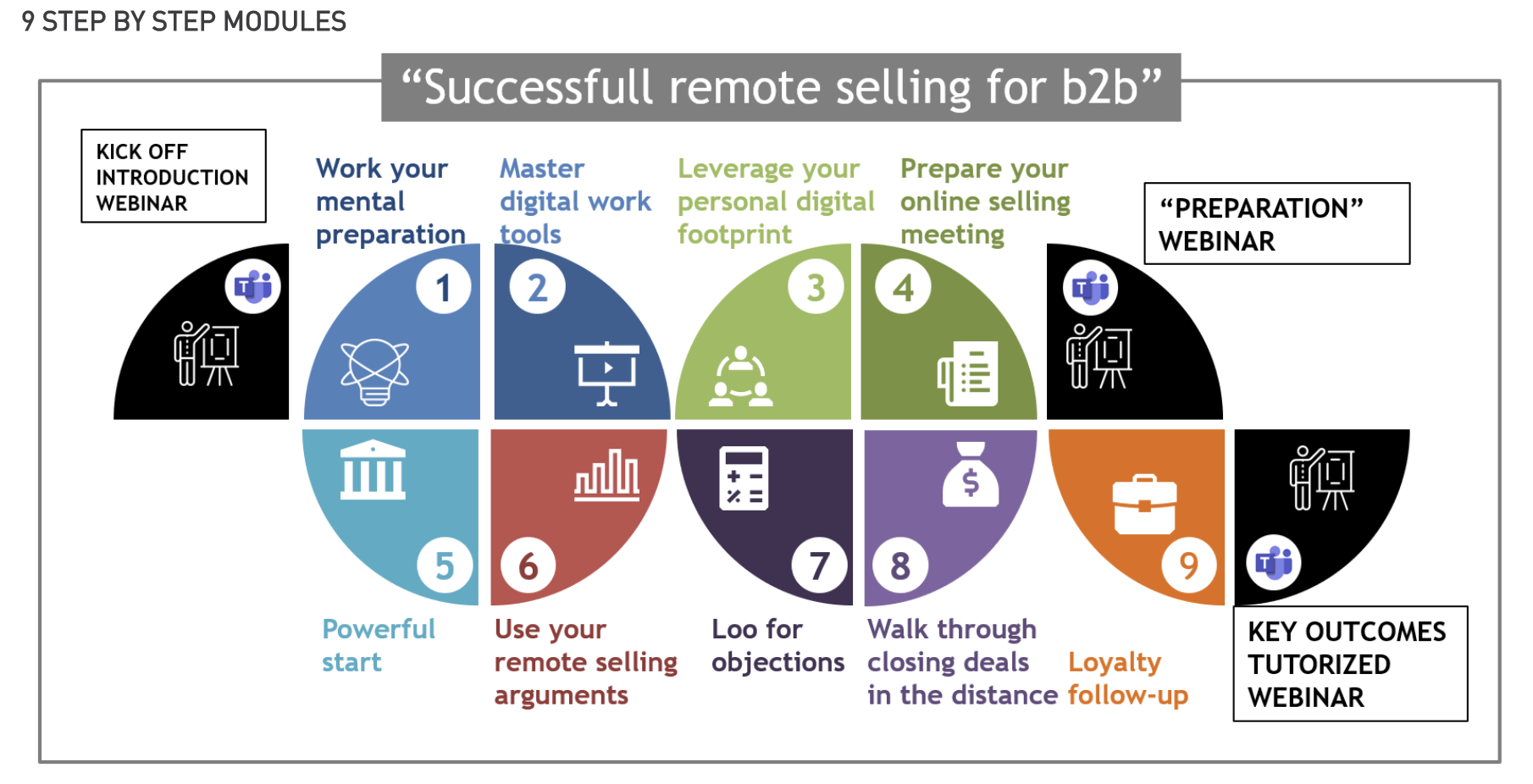Sixty-four per cent of B2B companies plan to increase the number of ‘hybrid’ salespeople (who interact with clients via video, phone, apps, and occasionally in person) within the next six months (B2B Pulse: Insights from our latest global survey | McKinsey, 2021)
Although having to spend more time in isolation has shaken up the customer journey, it should not be assumed that human relationships have completely disappeared. On the contrary, salespeople have had to work twice as hard and remote selling has naturally become the norm. In the following article, find out if remote selling, which is essential in these times of crisis, is now a threat or an opportunity for traditional sales.
Remote selling, yes, but still?
“Remote selling is a beneficial and even necessary development for salespeople" Georges Da Silva, COO de Salesapps
What is remote selling?
Remote selling refers to the fact that a sale is made at a distance without any physical contact with the client: it can therefore be a sale by phone, by video conference or by chat. However, remote selling assumes there is a verbal exchange between at least two people: the salesperson and the client.
Is remote selling here to stay?
Since 2020, remote selling has been gaining ground to deal with the COVID-19 crisis, but will it disappear as soon as everything returns to normal? Nothing is less certain as it has transformed commercial relationships. Once the difficulties of implementation and adaptation have been overcome, it seems the advantages could outweigh the disadvantages and that there is no turning back.
Remote selling: opportunities to be seized
“Problems are the favourite disguise of opportunities” citation anonyme
When remote selling is used to improve performance
With remote selling, if you can move mountains, you can move molehills! As soon as less time is spent travelling to meet clients, you have more time and can increase the number of appointments. Salespeople take advantage of remote selling to double the number of daily meetings, from three to four meetings to six or seven.
What’s more, doubling the opportunities to present your commercial offer means doubling your sales opportunities!
Clients are also more available to arrange meetings because they spend less time on them, and clients the furthest away are now within reach. This is the perfect way to review your entire portfolio to get back in touch with clients who have been neglected or to develop your prospecting territory without geographical limits.
The chance to add value, the keystone of remote selling
Many salespeople have been unsettled by videoconferencing. With no more warm handshakes or glances received with a friendly smile, there is only one real lever left for salespeople to make a difference: the added value of what they have to sell! Style has taken a back seat and it is substance that has taken centre stage! What you sell needs to reflect the real needs of the client and provide a concrete solution, because that is what will capture their attention.
What if remote selling were a way to invite key contacts to meetings?
Thanks to videoconferencing, sales meetings are now open to all possible and imaginable contacts! Does your client want to bring in an expert to ask the sales representative specific questions? Or does the CEO of a company based in the capital want to attend a meeting with a major client based in the countryside? Anything is possible: you just have to learn how to coordinate the schedules of both parties.
Make your discussion even more interactive with remote selling
A wide range of presentation media help make discussion more dynamic, from PowerPoint to iPanorama 360 and PDF etc. Screen-sharing is used in remote selling to foster collaboration and stimulate shared knowledge! By involving the client in discussions and getting them to participate, remote selling lets you go further in defining joint projects.
Remote selling or how to optimise sales for everyone’s benefit
With clients delighted to have fewer trips to organise, salespeople happy to increase the number of meetings and see their clients satisfied, remote selling is an invaluable vehicle of opportunity! And to top it all off, with remote selling, companies reduce their carbon footprint and the environment is much better off. That’s one more argument to enhance a brand’s image.

Successful remote selling for B2B - source : actitudpro.com
After the opportunities, the threats
Eighty-five per cent of B2B companies expect hybrid salespeople to become the most common sales profiles in their organisation within the next three (B2B Pulse: Insights from our latest global survey | McKinsey, 2021)
Let’s face it, remote selling isn’t easy every day! Even if it offers many opportunities, salespeople have to go through a real process of questioning and adapting, which is not the easiest thing in the world. Those who refuse to go through this process risk being left behind...
Sales staff have to get out of their comfort zone
For salespeople who thought remote selling was only a temporary phase in response to a temporary economic context, they might be in for a nasty shock! There is no turning back and salespeople now need to adopt strategies to make the customer experience more pleasant during remote selling. They need to know how to pitch their voice, present content that captures attention, manage discussion and arrange meetings, all with great diplomacy because their sympathy capital is limited by the distance.
They also have to strengthen their sales pitch by focusing on the added value and quality of the product rather than charming buyers. They need to succeed in building a relationship of trust with less control over the relational aspect of the meeting and compensate with a clear and powerful sales pitch.
The B2B sales levers are still there but they are activated differently
In B2B, there are three main sales levers: the quality of the client relationship; the need to create value in the eyes of the client or prospect; and the ability to create a dynamic of change to build an impactful commercial relationship.
In remote selling, these three levers continue to exist, but the salesperson has to review the way they are activated.
To develop client relations, the salesperson has to demonstrate communicative leadership and rely less on their sympathy capital. To reinforce value creation, they need to review their sales pitch and focus on the value proposition; and finally, to change the dynamic, the salesperson has to find the digital tools to facilitate remote collaboration.
After enhancing the substance, the style needs to be professional
From a purely technical point of view, salespeople are no longer allowed to make mistakes! While they may have gone wrong at times when first videoconferencing, in the long term it is essential to become professional in remote selling.
The quality has to be there, both in terms of the computer network and the equipment used. It is no longer acceptable to be asked the question, “can you hear me?” 10 times during a 40-minute appointment. Mediocre equipment requires more effort of concentration from the client and the risk of leaving increases.
To lead a meeting, the salesperson needs to work on their camera presence: they need proper clothing, a professional background and a constant camera gaze without being distracted by their phone or by their own face while remembering to pay attention to the light.
Finally, they need to know how to structure the meeting; this involves giving instructions or advice from the beginning to channel discussion, providing the client with a checklist to prepare for the meeting, proposing different interaction media, being punctual and creating space for informal chat before the meeting.
Managing the length of meetings during remote selling
Sales staff need to know how to manage their time. A remote meeting is shorter than a normal meeting because the client’s attention span is reduced. Twenty to 50 minutes of meeting time should be enough to present the commercial offer and answer the client’s questions. This means you need to give a punchy sales pitch while getting to the point.
All these adjustments require salespeople to double down their efforts and they have to jump on the bandwagon!
What if we made remote selling a business strategy?
Around two-thirds of B2B buyers now prefer remote or digital self-service interactions (B2B Pulse: Insights from our latest global survey | McKinsey, 2021)
Remote selling is becoming a real sales strategy that companies need to develop and strengthen.
Define a process that makes sense
Holding a remote meeting is not something you can improvise. The contributors need to test their equipment, establish rules of conduct, work on an approach and learn to develop a commercial relationship based on different criteria than in person. It is therefore in the best interest of companies to start working now on the process best suited to meet the requirements of remote selling while representing their image as faithfully as possible.
Invest in tools for remote selling
To optimise your remote selling strategy, don’t think your equipment is limited to a good camera and a good microphone. More and more tools are being developed to facilitate remote collaboration, such as applications to centralise content or update information in real time.
Recruit ‘hybrid’ salespeople to use the specific skills of remote selling
There is no doubt that in the coming years, the typical salesperson will have to master remote selling. Knowing how to present at a distance, establishing a rapport, building a value argument and being able to switch from one communication method to another to adapt to the client, all with a high level of professionalism—this is what we expect from salespeople 3.0!
How can you continue to assess your employees’ performance remotely?
Despite the distance, managers still need to support their teams in achieving business objectives, whether collective or individual. It is clear that the use of incentive compensation based on quantitative performance targets is still a very effective tool, and home working does not affect this; in fact, it is a way of measuring employees’ efforts. However, for some managers who are asked to evaluate their employees’ work qualitatively, remote working can represent an additional difficulty in terms of evaluation fairness. To help them, mini training programmes called Training On Demand are available here.





